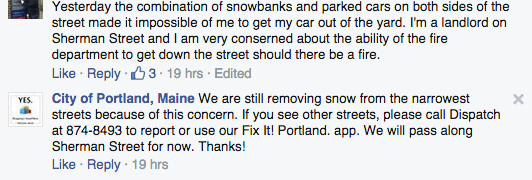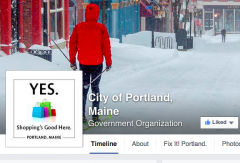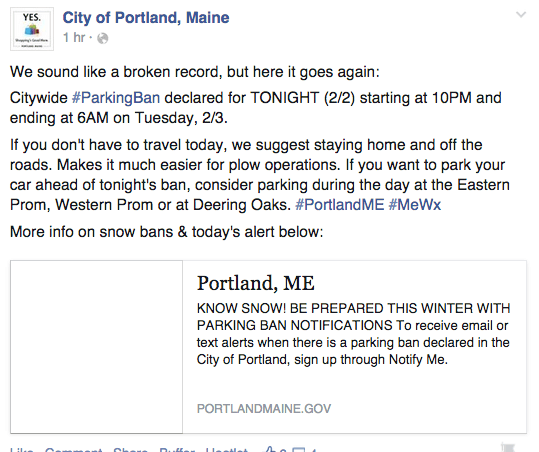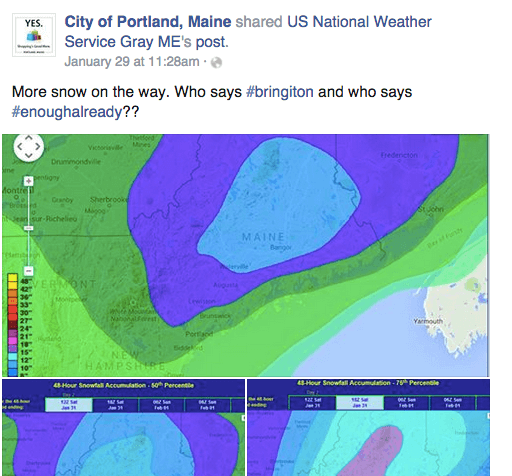By Laura Petrolino
As I look outside my window, it is a blur of white.
There are a few skiers going by, a snowshoer here and there, and a random cyclist (only in Maine do cyclists take the same routes as skiers).
Because the city of Portland uses social media for government communications, I notice a notification from them on Facebook.
The city is under another parking ban, which means parked cars can’t be on the street so the city can plow.
I also got an email and text message about the ban, because being the communication freak-azoid I am, I wanted ALLLL the notifications.
I like their Facebook page the best, though, because rather than being a dull, stiff, whomp, whomp government drone trying to fit Facebook to meet its needs, the City of Portland Facebook page projects a helpful, casual, and fun personality, which really echoes the state itself.
Successfully Use Social Media for Government Communications
Faced with our third big storm in the last week, the City of Portland Facebook was right there with the rest of us in its feelings about the weather:
Clear, to the point, and informative, but still maintaining a voice and sense of personality.
This city uses the Facebook page to:
- Keep citizens informed.
- Answer questions and respond to concerns, or point citizens in the right direction.
- Share updates from other government entities like the Fire Department or Parks and Rec (both also on Facebook.)
- And even engage fans.
And Don’t Forget Twitter
But have no fear Facebook haters, the city of Portland also has you covered on Twitter. The city uses Twitter to share important updates and information, but also to serve as a curator for what’s going on in our fine town.
From concerts to library events, jobs and airport cancellations, the @CityPortland Twitter handle acts as a one stop shop of all the goings-on Mainers in the know, need to know.
By using multiple channels—Facebook, Twitter, text, and email—the city is able to communicate with a larger population of citizens through whichever channel they prefer. This helps them get their message out farther, quicker.
Kick the Drone Stereotype
Many government agencies are scared to get involved in digital communication out of a concern it will open up too much risk and give citizens an open platform to air grievances. And, in fact, that’s exactly what it will do. But when handled correctly and with an appropriate communications strategy in place, that’s a good thing.
Having multiple digital platforms to allow citizens to communicate through—turn to for answers or address concerns—actually allows government organizations greater control of the conversation.
The same holds true for government organizations as does for any other business brand—when people don’t know where to turn to provide feedback and get help, brand sentiment plummets.
Frustrations are amplified and the “airing of grievances” becomes very public and often mob-like.
Instead, when you give your consumer or community greater control by providing multiple communications channels, you eliminate a lot of the frustration.
You build trust and help citizens feel as if they are listened to, and that alone will calm the hordes.
Be Prepared to Succeed
Organizations wanting to use social media for government communications shouldn’t jump in without a plan. A social strategy must be put in place that integrates with all other communications.
Asking the following questions are a good place to start:
- How are you going to maintain a clear brand voice throughout all channels? Having a personality document is key here. This will allow anyone managing a brand channel to clearly understand the goal of the brand voice, along with any necessary dos and don’ts.
- Do you have a clear customer service communications tree set up? A big part of using social media for government communications is going to be customer service. This means, like any organization using social media for customer service, you must have very clear guidelines for everyone manning a communications channel of what issues they can address first hand and what issues they can’t. For those that cannot be address through the communications platform itself, there needs to be a communications tree outlining where that customer should be directed.
 Likewise all communications managers should be trained in proper customer service protocol (as show really well in the dialogue above.)
Likewise all communications managers should be trained in proper customer service protocol (as show really well in the dialogue above.) - Do you have a crisis communications plan in place? With great power, comes great responsibility and if you use social for the little things you must be prepared to use it for the big things as well. You are training your community to turn to social to find answers, and that is even more important in the face of a large scale emergency situation. Have a plan, rehearse the plan, and train new employees immediately.
Of course these questions serve as the starting point. What other advice would you give organizations hoping to use social media for government communications?



